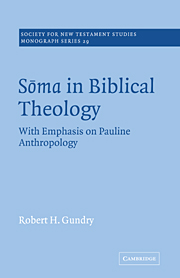Book contents
- Frontmatter
- Contents
- Acknowledgements
- Abbreviations
- PART I FOR AND AGAINST A HOLISTIC DEFINITION OF SŌMA
- PART II SŌMA IN THE FRAMEWORK OF ANTHROPOLOGICAL DUALITY
- PART III THE THEOLOGY OF SŌMA AS PHYSICAL BODY
- 13 The sōma in death and resurrection
- 14 Sōma and the being of man
- 15 Sōma, sin, and salvation
- 16 Sōma, individuality, and solidarity
- 17 Sōma and the Church as the Body of Christ
- Select bibliography
- Index of passages cited
- Index of authors
15 - Sōma, sin, and salvation
Published online by Cambridge University Press: 14 January 2010
- Frontmatter
- Contents
- Acknowledgements
- Abbreviations
- PART I FOR AND AGAINST A HOLISTIC DEFINITION OF SŌMA
- PART II SŌMA IN THE FRAMEWORK OF ANTHROPOLOGICAL DUALITY
- PART III THE THEOLOGY OF SŌMA AS PHYSICAL BODY
- 13 The sōma in death and resurrection
- 14 Sōma and the being of man
- 15 Sōma, sin, and salvation
- 16 Sōma, individuality, and solidarity
- 17 Sōma and the Church as the Body of Christ
- Select bibliography
- Index of passages cited
- Index of authors
Summary
On the one hand, sōma consistently refers to a physical entity, and, on the other hand, Paul can designate it ‘the body of sin’ (Rom 6: 6) and associate it with the ‘flesh’ in a sinful sense (Rom 8: 4–13). A question naturally arises concerning the relationship between sōma, sin, and salvation from sin.
In the nineteenth century C. Holsten and H. Lüdemann, continuing a line of F. C. Baur, propounded the view that under heavy influence from Hellenistic thought Paul saw the physical body as inherently evil and salvation as deliverance from that body. As with the views of those scholars concerning Paul's doctrine of bodily resurrection, it is now commonly agreed that they vastly overestimated Hellenistic influence on Paul, underestimated the force of his Judaistic background, and engaged in minimizing exegesis of the numerous Pauline passages where the physical body appears positively as the temple of the Holy Spirit, an object of sanctification, and an instrument of righteousness – to say nothing of its destined resurrection, already discussed here. Conversely, they over-interpreted those passages where Paul associates the body and sin by transmuting the association into an equation. Paul writes of the body only as the victim of sin, not as the origin of sin. These scholars mistook the influence of nineteenth century idealism on them for Hellenistic influence on Paul. Hence, their view is largely and rightfully disregarded nowadays.
But philosophical influence on historico-critical exegesis was not to be denied.
- Type
- Chapter
- Information
- Soma in Biblical TheologyWith Emphasis on Pauline Anthropology, pp. 204 - 216Publisher: Cambridge University PressPrint publication year: 1976



